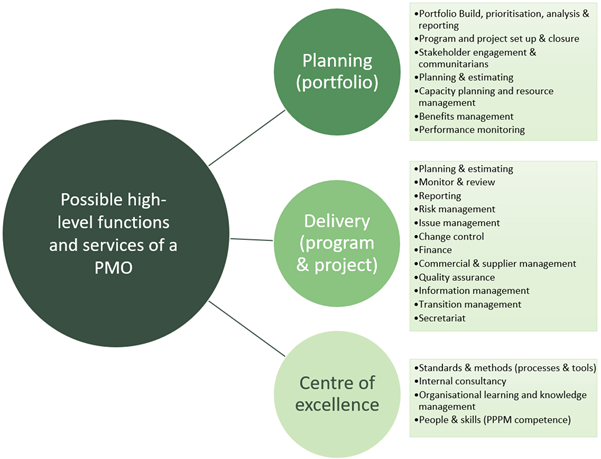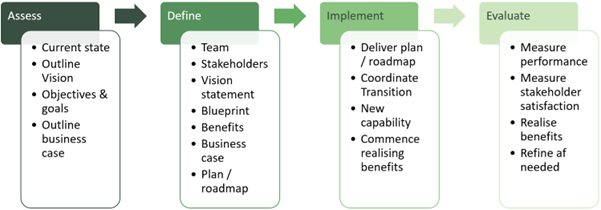How to create a Project Management Office that works for you
So, what is a PMO?
A PMO, or a Project Management Office, is a team that helps you manage your projects more effectively. A PMO can help you align your projects with your strategy, improve your project outcomes, enhance your project governance, increase your project capability, optimise your project resources, and reduce your project risks.
But not every Project Management Office is the same. Depending on your organisation’s culture, structure, and environment, you may need a different type of PMO. One that is too big or too small for your organisation may not deliver the value you expect. A PMO that is too complex or too simple for your organisation may not meet the needs of your stakeholders. A PMO that is not aligned with your strategy may not get the support or adoption needed from your organisation.
The model below shows many of the high-level functions and services a PMO can perform:

That’s why you need to create a PMO that works for you. A PMO that works for you is a PMO that is tailored to fit your needs, customised to suit your context, optimised to match your goals, adapted to your environment, and aligned to your vision. A PMO that works for you can provide the following benefits:
- Maximise the value and return on investment (ROI) of your PMO.
- Minimise the complexity and bureaucracy of your PMO.
- Customise your PMO’s services and deliverables to meet the expectations and needs of your stakeholders.
- Foster acceptance and adoption of your PMO by your organisation.
How do I create or change a PMO?
But how do you create a PMO that works for you? How do you know what is the best fit for your organisation? How do you implement and manage the changes required to achieve the desired state of your PMO?
A proven approach to creating a PMO that works for you consists of the following steps and key activities below:

- Assess: Assess the current state of your project management practices and capabilities. Identifying the strengths, weaknesses, opportunities, and threats of your current state. Also understand your vision, mission, objectives, and scope for your desired state of your PMO.
- Define: Define the gap between the current and desired states of your PMO. Outline the actions and deliverables required to close the gap and achieve your desired state. Develop a roadmap and a work plan to guide and support the implementation process.
- Implement: Implement the roadmap and work plan using project management best practices and methodologies. Coordinate and execute the actions and deliverables required to create a PMO that works for you. Also monitor and control the progress and performance of the implementation process using key performance indicators (KPIs), metrics, and feedback mechanisms.
- Evaluate: Evaluate the outcomes and benefits of creating a PMO that works for you. Measure the level of satisfaction of your stakeholders with your PMO’s services and deliverables. Also, verify the compliance of your PMO’s processes and practices with best practices and standards. Capture the lessons learned and recommendations for continuous improvement.
Need help to set up, review, or refine your PMO? Like to discuss this further? We’d love to chat, preferably over a coffee.
This article was written my former 2PM Principal Consultant, Steve Armitage.
